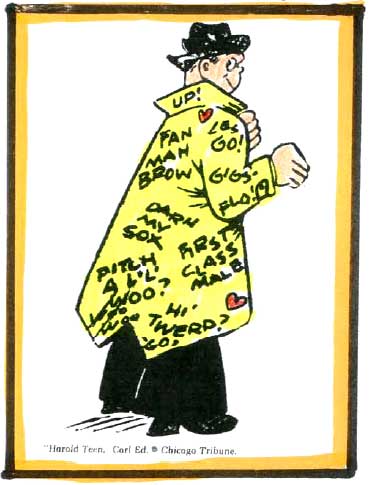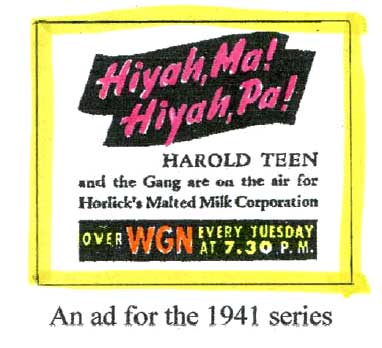|

This story was published in Radio Recall, the journal of the Metropolitan Washington Old-Time Radio Club, published six times per year.
Click here to return to the index of selected articles.
|
|
THE RADIO LIVES OF HAROLD TEEN: 1930 to 1950
by Ryan Ellett © 2011
(From Radio Recall, August 2011)
Radio programs featuring teenage protagonists are represented in the collections of many old time radio enthusiasts by episodes of Archie Andrews and Meet Corliss Archer, both of which debuted in 1943. However, thirteen years before these well-known programs hit the airwaves Harold Teen, possibly the first of such teen-themed series, entertained listeners in the Chicago area.

Premiering as a Sundays-only comic strip on May 4, 1919, in the Chicago Tribune, The Love Life of Harold Teen became the first such effort to reflect the life of the era's teenagers according to Carl Ed, the strip's writer and drawer. The idea for Harold Teen actually came from Joseph Patterson, co-publisher of the Tribune who felt that a comic featuring teenage characters would be popular with readers. Not long after its debut the comic proved popular enough to become a daily feature beginning September 25, 1919, in the New York Daily News, also owned by Patterson. Eleven years later as radio was rapidly capturing the public's imagination, Chicago's WGN adapted Harold Teen for the airwaves, thus becoming one of several Tribune comics which would be turned into radio features.
The show, entitled simply Harold Teen, debuted in June of 1930 featuring a quintet of Chicago-area actors, at least one of whom would become very prominent in the industry. Playing the lead role of Harold Teen was Willard Farnum, a graduate of suburban Northwestern University where he starred in school productions. Fellow Northwestern alum Eunice Yanke played Lillums Lovewell, Harold's girlfriend. Jack Spencer portrayed the football-playing jock, Beezie Binks.
Filling out the group of fun-loving teens were Lilacs and Giggles, played by Wally Colbath and Ireene Wicker respectively. Wicker also played the part of Harold's little sister, Josie, whenever the character was written into the story. Late in the program's run Ruth Dennen assumed the part of the new girl, Cicely, in May, 1932, and around that time Gayle Hinton joined the cast in an unknown role.
Lead Willard Farnum went on to a successful radio career through the 1930s which included stints on Dan Harding's Wife, Flying Time, Midstream, A Tale of Today, Way Down Home, Today's Children, and Woman in White. Eunice Yanke, the top-billed female character, had a short radio career, appearing in addition to Harold Teen only in WGN's The Silver Thread, a mystery-adventure which followed two sisters but ran for just a few weeks in late 1932. Ireene Wicker, the most famous alum of the original Harold Teen, is widely remembered among the old time radio community for her long-running role as The Story Lady.
Jack Spencer had a minor radio career compared to Farnum and Wicker but one certainly worth noting. Harold Teen was by far his longest aural job but he is also documented with appearances on Easy Aces in early 1932, just a few months after the Goodmans had relocated from Kansas City. That summer Spencer toured the Chicago region as a member of the WGN Minstrels which also included Hal Gilles, formerly of Louie's Hungry Five, and a young Marlin Hurt. In 1933, after Harold Teen had left the air, Spencer hosted a thrice-weekly Railway Inn, his last known radio work before moving to Hollywood sometime in the mid-1930s.
Wally Colbath is remembered for this athleticism more than his acting skills. He was a national intercollegiate diving champion at Northwestern in 1928, 1929, and 1930 and a member of the 1928 and 1932 United States Olympic teams, earning a bronze medal in 1928. He eventually got into warehousing and moved to Indianapolis after World War II. His son, Walter Colbath, Jr., erroneously indicated his father was the first to play Jack Armstrong; this may be an incorrect family memory that actually refers to the elder Colbath's time on Harold Teen.
Ruth Dennen was known more for her singing abilities than her acting and is documented to have sang around Chicago for many years. This series is her only known radio work. Gayle Hinton, who was a latecomer to Harold Teen, had earlier attended the University of Wisconsin. In November, 1932, she married and she and her husband relocated to Peoria, IL, presumably ending any radio aspirations she may have held.
Harold Teen was broadcast for a quarter-hour Monday through Saturday at 6:45 (later 6:15 then 5:15) and penned by Blair Walliser, a Northwestern graduate, Phi Beta Kappa member, and writer of WGN material since the summer of 1929. In college Walliser honed his writing skills in local humor magazines Purple Parrot and The Scrawl. His first writing work for WGN involved a series of scripts for Sunday afternoon children's concerts. Walliser also took at least one acting role on Harold Teen, the part of Simile Jones, an African American female hired by Pop Jenks, proprietor of the teen hangout the Sugar Bowl. Later in the decade Walliser worked on Backstage Wife, Curtain Time, Front Page Farrell, Jungle Jim, and Romance of Helen Trent, primarily as director.
Like the comic strip, the live action series revolved around the timeless travails of adolescence, and were often centered at the Sugar Bowl, a popular hangout run by Mortimer “Pop” Jenks. Aimed at teenage listeners, “Pop” Jenks provided a voice for adult listeners who happened to tune in. Harold Teen was, perhaps, one of the first radio efforts to make liberal use of popular teen slang of the day, or “highschoolegiate slanguage” as writer Walliser good-naturedly called it. It wasn't all jokes; In June, 1932, the series introduced Philip Space, a character who was both deaf and mute and worked as a clerk at the Sugar Bowl.
On March 17, 1932, the cast of Harold Teen celebrated their 500th broadcast after 21 months on the air. Not long afterward writer Walliser was promoted to production manager at the station and began to oversee the productions of Goodman Ace's Easy Aces and Bob Becker's outdoors programs, both of which were picked up by the CBS network. The pioneering teen series left WGN in June, 1932, to make way for the station's coverage of the presidential conventions. In the meantime, Farnum and Yanke headed to California to take screen tests for possible motion picture work. Though the station indicated Harold Teen would be back on the air after the summer's political events wound down, the popular comic strip of the air did not return.
At least, it did not return immediately. Nearly a decade later WGN brought Harold Teen and his gang of friends back to the airwaves in 1941. Once again Blair Walliser directed and he may very well have been the impetus behind the revival. The new cast was entirely different: the lead role of Harold Teen was given to Eddie Firestone while his girlfriend Lillums was played by Loretta Poynton, who, apocryphally got into radio by accident when she mistakenly entered a studio during an audition and had a script thrust into her hands. Bill Evenson was cast as Lilacs and Marvin Mueller as Beezie. Teen's pal Shadow Smart was portrayed by Bob Jellison while Gail Henshaw and Willard Waterman were picked as Harold's parents. The audition was put on before 600 Chicago land high school students at 3:45 on March 14, 1941.
The audition didn't fly and Walliser went back to work polishing the concept. On July 29 WGN tried again and Harold Teen was on the air as a half-hour Tuesday night feature (7:30 – 8:00). This time Charles Flynn earned the title role in the Horlick's Malted Milk-sponsored broadcast. Said Walliser of any actor who would play Teen: “The actor who plays Harold must have just the right kind of voice and a personality which he could inject into the part to give it smoothness and naturalness. When his voice reaches the listeners, they must immediately have a picture of a young lad of 17, the typical American youth who is full of fun, gets into a lot of trouble, and is not sure what to do about it all.” Flynn had already received important parts on the serial Bachelor's Children while his mother, Bess Flynn, had written for WGN for several years.
The rest of the cast carried over from the March audition with Jellison, Poynton, Waterman, Henshaw, and Mueller being joined by 11-year-old Rosemary Garbell as Josie, Harold's sister, and Beryl Vaughan as one of Harold's beau's, Cynthia. The writing chores were handled by Fred Kress. The premier episode featured a well-worn story; Harold finds himself trying to escort two girls to the same dance without the two being aware of each other.

In a story line from August, 1941, by which time Harold Teen was heard over the Mutual Broadcasting System, Harold and his friends attempted to make some movies. Over several weeks Harold worked to raise money for his project and he finally found success when the local police department agreed to fund one picture in exchange for the opportunity to show it at their annual benefit dance. While filming the mystery thriller in an authentic haunted house, hi-jinx ensued when a gang of bank robbers decided to hide out in the same house.
Judy Ton, a Columbus, OH, transplant, joined the cast of Harold Teen in October, 1941. On her debut broadcast she played both a housewife and an African-American maid. On December 21, 1941, the cast of Harold Teen appeared on WGN's Citizens of Tomorrow program which normally showcased local high school students. Bob Jellison, Harold Teen's Shadow Smart, also had a regular role on Citizens. This second dramatized version of Harold Teen left the air in January, 1942, a much shorter run than the original series but more widely heard.
Radio was not done with Harold Teen; WGN brought the character back in March, 1948, on a program called Swinging at the Sugar Bowl. This new disc jockey series, aired at 12:30 on Saturdays, featured Fred Reynolds as Harold Teen and occasional guests such as Frances Langford, John Hall, and Lena Horne. Reynolds was a Middletown, CT, native and record enthusiast who had a collection numbering upwards of 5,000 albums. Choosing the Harold Teen moniker was not happenstance; he married the daughter of Harold Teen creator Carl Ed. Harold Teen's platter-spinning days lasted into January, 1950, but Reynolds continued to pen a regular column for the Tribune called “Platter Chatter” into 1956. He later worked for RCA Victor.
Carl Ed died October 10, 1959, just two weeks after retiring from cartooning. The family soon announced that after the final strips Ed had penned were run, the 40-year-old strip would come to an end. Harold Teen left the newspapers in November, 1959. While collections of the long-running comic strip have been published over the years, no recordings of any of of the three Harold Teen radio series are known to be in circulation among old time radio fans. In addition to three radio versions over a span of nearly twenty years, Harold Teen was the star of two motion pictures, the first in 1928 with Arthur Lake as Harold and the second in 1934 with Hal LeRoy in the lead.
|